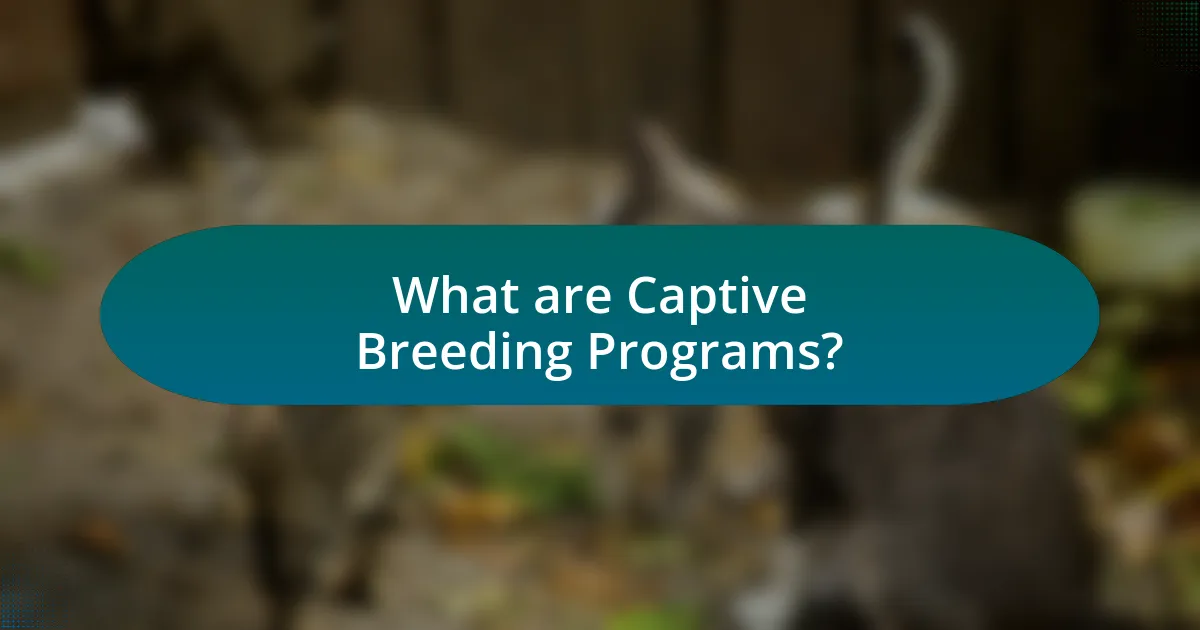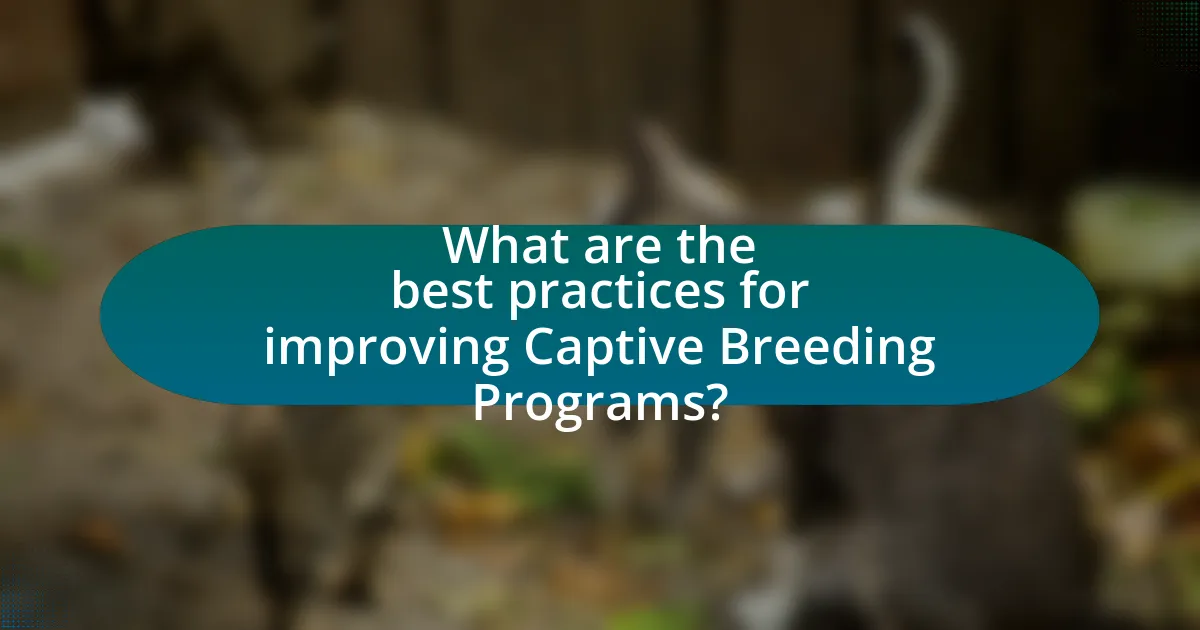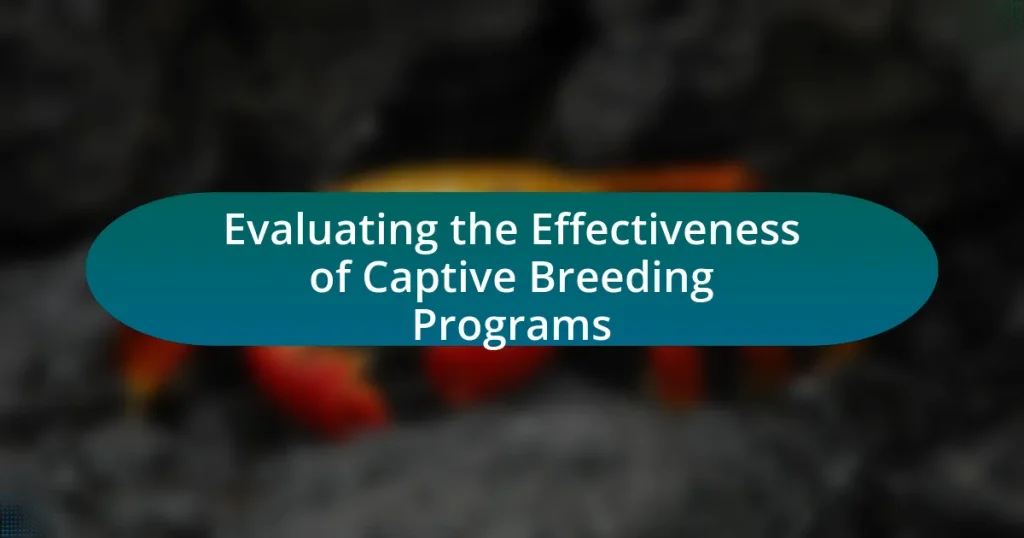Captive breeding programs are conservation initiatives aimed at increasing the population and genetic diversity of endangered species in controlled environments, such as zoos and wildlife reserves. This article evaluates the effectiveness of these programs by examining their operational methods, the species involved, and the facilities required for success. It also discusses the importance of captive breeding in biodiversity preservation, the challenges faced, and the metrics used to assess program outcomes. Additionally, best practices for enhancing these programs, including genetic management and public engagement strategies, are highlighted to demonstrate their role in successful species conservation efforts.

What are Captive Breeding Programs?
Captive breeding programs are conservation efforts aimed at breeding endangered or threatened species in controlled environments, such as zoos or wildlife reserves. These programs are designed to increase population numbers, maintain genetic diversity, and ultimately reintroduce species into their natural habitats. For example, the California condor was brought back from the brink of extinction through a captive breeding program initiated in the 1980s, which successfully increased its population from 27 individuals to over 500 today.
How do Captive Breeding Programs operate?
Captive breeding programs operate by collecting individuals from wild populations to breed them in controlled environments, aiming to increase population numbers and genetic diversity. These programs typically involve selecting breeding pairs based on genetic compatibility, monitoring health and reproduction, and providing optimal conditions for raising offspring. For instance, the California condor recovery program has successfully increased the population from 27 individuals in 1987 to over 500 today through such methods. This demonstrates the effectiveness of captive breeding in species conservation.
What species are typically involved in Captive Breeding Programs?
Species typically involved in captive breeding programs include endangered animals such as the California condor, black-footed ferret, and Arabian oryx. These species are often selected due to their declining populations in the wild and the need for conservation efforts to prevent extinction. For instance, the California condor was brought back from the brink of extinction through a captive breeding program initiated in the 1980s, which successfully increased its population from just 27 individuals to over 500 today. Similarly, the black-footed ferret, once considered extinct in the wild, has seen population recovery through targeted breeding efforts. These examples illustrate the critical role captive breeding programs play in species conservation.
What facilities and resources are required for successful Captive Breeding?
Successful captive breeding requires specialized facilities such as controlled environments, breeding enclosures, and appropriate habitat simulations. These facilities must include climate control systems to maintain optimal temperature and humidity, as well as water filtration systems to ensure clean water supply. Additionally, resources such as veterinary care, nutritional support, and genetic management tools are essential for maintaining the health and genetic diversity of the breeding population. Research indicates that well-designed facilities significantly enhance breeding success rates, as evidenced by programs that have successfully reintroduced species into the wild, demonstrating the importance of these resources in achieving conservation goals.
Why are Captive Breeding Programs important?
Captive breeding programs are important because they play a crucial role in the conservation of endangered species. These programs help to increase population numbers, maintain genetic diversity, and provide a safety net against extinction due to habitat loss, poaching, or other threats. For instance, the California condor was brought back from the brink of extinction through a successful captive breeding program, which increased its population from just 27 individuals in the 1980s to over 500 today. This demonstrates the effectiveness of captive breeding in preserving biodiversity and restoring species to their natural habitats.
What role do they play in conservation efforts?
Captive breeding programs play a crucial role in conservation efforts by helping to increase the population of endangered species and restore genetic diversity. These programs provide a controlled environment where species can reproduce safely, mitigating threats such as habitat loss and poaching. For instance, the California condor was brought back from the brink of extinction through a captive breeding program, which successfully increased its population from 27 individuals in 1987 to over 500 today. This demonstrates the effectiveness of captive breeding in not only preserving species but also facilitating their reintroduction into the wild, thereby enhancing overall biodiversity.
How do they contribute to biodiversity preservation?
Captive breeding programs contribute to biodiversity preservation by increasing the population numbers of endangered species and facilitating their reintroduction into natural habitats. These programs help maintain genetic diversity, which is crucial for the long-term survival of species, as evidenced by the successful reintroduction of the California condor, which saw its population rise from 27 individuals in 1987 to over 500 today due to captive breeding efforts. Additionally, captive breeding can serve as a safeguard against extinction caused by habitat loss, poaching, and climate change, thereby playing a vital role in conservation strategies.
What challenges do Captive Breeding Programs face?
Captive breeding programs face several challenges, including genetic diversity loss, behavioral changes in species, and difficulties in reintroduction to the wild. Genetic diversity loss occurs when breeding is limited to a small population, leading to inbreeding and reduced adaptability. Behavioral changes can result from animals being raised in controlled environments, making them less capable of surviving in natural habitats. Additionally, reintroduction efforts often encounter obstacles such as habitat destruction and competition with wild populations, which can hinder the success of these programs. These challenges highlight the complexities involved in effectively conserving species through captive breeding initiatives.
What are the common issues related to genetic diversity?
Common issues related to genetic diversity include inbreeding depression, loss of adaptive potential, and reduced resilience to environmental changes. Inbreeding depression occurs when closely related individuals breed, leading to a decrease in genetic variation and an increase in the likelihood of genetic disorders. Loss of adaptive potential limits a population’s ability to adapt to changing environments, which is critical for survival. Reduced resilience to environmental changes makes populations more vulnerable to diseases and climate fluctuations, ultimately threatening their survival. These issues are particularly relevant in captive breeding programs, where limited genetic diversity can hinder the long-term success of species reintroduction efforts.
How do environmental factors impact the success of these programs?
Environmental factors significantly influence the success of captive breeding programs by affecting habitat quality, species behavior, and genetic diversity. For instance, the availability of natural resources such as food and shelter directly impacts the health and reproduction rates of captive-bred species. Research indicates that programs that mimic natural habitats tend to yield higher survival rates and successful reintroductions, as seen in the California condor recovery efforts, where habitat restoration played a crucial role in increasing population numbers. Additionally, environmental stressors like climate change can alter breeding cycles and habitat suitability, further complicating the success of these initiatives. Thus, understanding and addressing environmental factors is essential for enhancing the effectiveness of captive breeding programs.

How is the effectiveness of Captive Breeding Programs evaluated?
The effectiveness of Captive Breeding Programs is evaluated through metrics such as population viability, genetic diversity, and successful reintroduction rates. Population viability assesses whether the bred species can sustain itself in the wild, while genetic diversity ensures a healthy gene pool, reducing inbreeding risks. Successful reintroduction rates measure how many individuals survive and reproduce after being released into their natural habitats. Studies have shown that programs like the California condor recovery have increased population numbers from 27 individuals in 1987 to over 500 today, demonstrating the potential success of these evaluations.
What metrics are used to assess the success of these programs?
Success of captive breeding programs is assessed using metrics such as population viability, genetic diversity, and reintroduction success rates. Population viability measures the likelihood of a species surviving in the wild, often evaluated through population modeling. Genetic diversity is assessed by analyzing the genetic variation within the captive population, which is crucial for long-term survival. Reintroduction success rates are determined by tracking the survival and reproduction of individuals released into their natural habitats, with studies indicating that higher genetic diversity correlates with better adaptation and survival post-release. These metrics provide a comprehensive framework for evaluating the effectiveness of captive breeding initiatives.
How do survival rates of released individuals indicate program effectiveness?
Survival rates of released individuals serve as a direct indicator of the effectiveness of captive breeding programs. High survival rates suggest that the released individuals are well-adapted to their natural environments and that the breeding program successfully addressed key factors such as genetic diversity, health, and behavioral training. For instance, studies have shown that species with survival rates exceeding 70% post-release often indicate successful acclimatization and integration into wild populations, reflecting the program’s ability to prepare individuals for life outside captivity. Conversely, low survival rates may highlight deficiencies in the program, such as inadequate habitat preparation or insufficient behavioral conditioning, thus signaling the need for program adjustments to enhance future outcomes.
What role does population growth play in evaluation?
Population growth is a critical factor in evaluating the effectiveness of captive breeding programs. It serves as a primary indicator of the success of these programs in increasing species numbers and enhancing genetic diversity. For instance, successful captive breeding initiatives often lead to significant population increases, which can be quantitatively assessed through metrics such as population size, growth rate, and reproductive success. Studies have shown that programs aimed at endangered species, like the California condor, have resulted in population growth from just 27 individuals in 1987 to over 500 individuals today, demonstrating the direct impact of captive breeding on population dynamics. Thus, monitoring population growth provides essential data for assessing the overall effectiveness and sustainability of captive breeding efforts.
How do researchers measure the impact of Captive Breeding Programs on wild populations?
Researchers measure the impact of Captive Breeding Programs on wild populations primarily through population viability analyses, genetic assessments, and monitoring of reintroduced individuals. Population viability analyses utilize demographic data to predict the long-term survival of species, while genetic assessments evaluate the genetic diversity of both captive and wild populations to ensure healthy breeding practices. Monitoring involves tracking the survival, reproduction, and behavior of reintroduced individuals in their natural habitats, often using radio telemetry or camera traps. Studies, such as the reintroduction of the California condor, demonstrate that these methods effectively assess the success of captive breeding efforts, showing increased population numbers and genetic diversity in the wild.
What methods are used to track reintroduced species?
Methods used to track reintroduced species include radio telemetry, GPS tracking, and camera traps. Radio telemetry involves attaching a transmitter to the animal, allowing researchers to monitor its movements and behavior in real-time. GPS tracking provides precise location data at set intervals, enabling the analysis of habitat use and migration patterns. Camera traps capture images of animals in their natural habitat, helping to assess population dynamics and interactions. These methods have been validated in various studies, demonstrating their effectiveness in monitoring the survival and adaptation of reintroduced species in the wild.
How do comparisons with wild populations inform effectiveness assessments?
Comparisons with wild populations inform effectiveness assessments by providing a benchmark for evaluating the success of captive breeding programs. These comparisons allow researchers to analyze survival rates, reproductive success, and genetic diversity in captive-bred individuals relative to their wild counterparts. For instance, studies have shown that captive-bred species often exhibit lower fitness levels when reintroduced into the wild, highlighting the importance of understanding ecological and behavioral differences. By assessing these factors, conservationists can identify areas for improvement in breeding practices, ensuring that captive programs contribute effectively to species recovery and conservation goals.

What are the best practices for improving Captive Breeding Programs?
Best practices for improving captive breeding programs include genetic management, environmental enrichment, and comprehensive monitoring. Genetic management ensures genetic diversity by using techniques such as pedigree analysis and controlled breeding to avoid inbreeding, which can lead to health issues and reduced adaptability. Environmental enrichment enhances the well-being of captive animals by mimicking their natural habitats, thus promoting natural behaviors and improving reproductive success. Comprehensive monitoring involves regular health assessments and behavioral observations to track the effectiveness of breeding strategies and make necessary adjustments. These practices are supported by studies indicating that genetic diversity and enriched environments significantly enhance the survival and reproduction rates of captive-bred species.
How can genetic management enhance program outcomes?
Genetic management can enhance program outcomes by increasing genetic diversity and reducing inbreeding depression in captive breeding programs. By carefully selecting breeding pairs based on genetic compatibility, programs can maintain a healthy gene pool, which is crucial for the long-term viability of species. Studies have shown that higher genetic diversity leads to improved fitness, adaptability, and resilience against diseases, as evidenced by research conducted on the Florida panther, where genetic management efforts resulted in increased population growth and health.
What strategies are effective for maintaining genetic diversity?
Effective strategies for maintaining genetic diversity include implementing managed breeding programs, utilizing genetic monitoring, and promoting habitat connectivity. Managed breeding programs, such as those used in zoos and conservation facilities, aim to maximize genetic variation by carefully selecting breeding pairs based on genetic data. Genetic monitoring involves assessing the genetic health of populations through techniques like DNA analysis, which helps identify inbreeding and guides breeding decisions. Promoting habitat connectivity ensures that populations can interbreed with others, reducing genetic isolation and enhancing diversity. These strategies are supported by research indicating that genetic diversity is crucial for the adaptability and resilience of species, as seen in studies on captive breeding outcomes and wild population recovery efforts.
How can breeding protocols be optimized for success?
Breeding protocols can be optimized for success by implementing genetic diversity management, precise environmental control, and thorough monitoring of breeding outcomes. Genetic diversity management ensures that a broad gene pool is maintained, which is crucial for the health and adaptability of the population; studies have shown that populations with higher genetic diversity are more resilient to diseases and environmental changes. Precise environmental control, including temperature, humidity, and habitat enrichment, creates optimal conditions for breeding, as evidenced by research indicating that species-specific environmental factors significantly influence reproductive success. Additionally, thorough monitoring of breeding outcomes allows for data-driven adjustments to protocols, enhancing the likelihood of successful offspring production. For example, tracking reproductive rates and offspring viability can inform future breeding pair selections and habitat modifications, leading to improved program effectiveness.
What role does public engagement play in the success of Captive Breeding Programs?
Public engagement is crucial for the success of captive breeding programs as it fosters community support, raises awareness, and encourages participation in conservation efforts. Engaged communities are more likely to contribute resources, volunteer time, and advocate for policies that benefit these programs. For instance, studies have shown that programs with strong public involvement often see increased funding and volunteer participation, which directly enhances their operational capacity and effectiveness. Additionally, public engagement can lead to greater educational outreach, helping to inform the public about the importance of biodiversity and the role of captive breeding in species conservation.
How can education and outreach improve community support?
Education and outreach can significantly improve community support by increasing awareness and understanding of captive breeding programs. When communities are educated about the benefits of these programs, such as species conservation and ecosystem restoration, they are more likely to engage and support these initiatives. For instance, studies have shown that informed communities are more likely to participate in conservation efforts, as evidenced by a survey conducted by the World Wildlife Fund, which found that 75% of participants who received educational materials about local wildlife conservation were more inclined to support related initiatives. This demonstrates that targeted education and outreach efforts can foster a sense of ownership and responsibility among community members, ultimately leading to enhanced support for captive breeding programs.
What are effective ways to involve the public in conservation efforts?
Effective ways to involve the public in conservation efforts include educational programs, community engagement initiatives, and volunteer opportunities. Educational programs, such as workshops and school curricula, raise awareness about conservation issues and the importance of biodiversity. Community engagement initiatives, like local conservation projects and public forums, encourage participation and foster a sense of ownership among residents. Volunteer opportunities, such as habitat restoration and species monitoring, allow individuals to contribute directly to conservation efforts, enhancing their connection to the environment. Research shows that public involvement in conservation leads to increased support for policies and funding, as evidenced by the success of programs like the National Park Service’s volunteer programs, which have engaged thousands of citizens in conservation activities.
What practical tips can be applied to enhance Captive Breeding Programs?
To enhance Captive Breeding Programs, implementing genetic diversity management is crucial. This involves maintaining a broad genetic pool to prevent inbreeding, which can lead to reduced fitness and adaptability. Research indicates that programs with a focus on genetic diversity, such as the Florida panther recovery efforts, have shown improved population viability and resilience. Additionally, incorporating environmental enrichment in captive habitats can promote natural behaviors, leading to healthier breeding outcomes. Studies have demonstrated that enriched environments result in higher reproductive success rates, as seen in various avian species. Lastly, establishing partnerships with conservation organizations can facilitate knowledge sharing and resource allocation, further strengthening breeding initiatives.


